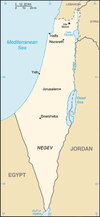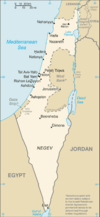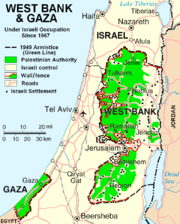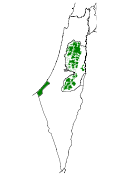- Demographics of Palestine
-
The Demographics of Palestine refers to the demography, or the statistical study of the population of Palestine. Studies of the subject can cover a wide historical and geographical scope, with the definition of Palestine varying throughout the ages, and from scholar to scholar. Some studies cover the present demography of Palestinian territories and its people, while others attempt to determine population figures for the geographical region of Palestine in antiquity, which can include the area covered by modern day Israel, the West Bank, Gaza Strip, Jordan, and parts of Syria and Lebanon. This article will provide an overview to the different demographic studies related to both the geographical region in antiquity through to the present.
Contents
Early demographics
See also: History of ancient Israel and Judah#Demographic history and Province of Judah#Administration and demographicsModern estimates place the population of ancient Palestine at a maximum of around one million. According to Israeli archeologist Magen Broshi, "... the population of Palestine in antiquity did not exceed a million persons. It can also be shown, moreover, that this was more or less the size of the population in the peak period - the late Byzantine period, around AD 600"[1] Similarly, a study by Yigal Shiloh of The Hebrew University suggests that the population of Palestine in the Iron Age could have never exceeded a million. He writes: "... the population of the country in the Roman-Byzantine period greatly exceeded that in the Iron Age...If we accept Broshi's population estimates, which appear to be confirmed by the results of recent research, it follows that the estimates for the population during the Iron Age must be set at a lower figure."[2] Reliable data on the population of Palestine in the pre-Muslim period, both in absolute terms and for the relative sizes of each community, do not exist.[3]
The highest population of the 3rd–7th centuries probably occurred in the Byzantine period.[3] Most scholars consider that the proportion of Jews decreased during these centuries. By counting settlements, Avi-Yonah estimated that Jews comprised half the population of the Galilee at the end of the 3rd century, and a quarter in the other parts of the country, but had declined to 10–15% of the total by 614.[3] On the other hand, by counting churches and synagogues, Tsafrir estimated the Jewish fraction at 25% in the Byzantine period.[3] Stemberger considers that Jews were the largest population group at the beginning of the 4th century, closely followed by the pagans.[4] In contrast to Avi-Yonah, Schiffman estimated that Christians only became the majority of the country's population at the beginning of the 5th century.[5]
Demographics in the Middle Ages
Main articles: Kingdom of Jerusalem#Crusader society and demographics and Ayyubid#DemographicsDemographics in the Ottoman period
In the middle of the first century of the Ottoman rule, i.e., 1550 CE, Bernard Lewis in a study of Ottoman registers of the early Ottoman Rule of Palestine reports:[6]
From the mass of detail in the registers, it is possible to extract something like a general picture of the economic life of the country in that period. Out of a total population of about 300,000 souls, between a fifth and a quarter lived in the six towns of Jerusalem, Gaza, Safed, Nablus, Ramle, and Hebron. The remainder consisted mainly of peasants, living in villages of varying size, and engaged in agriculture. Their main food-crops were wheat and barley in that order, supplemented by leguminous pulses, olives, fruit, and vegetables. In and around most of the towns there was a considerable number of vineyards, orchards, and vegetable gardens.
In his paper 'Demography in Israel/Palestine: Trends, Prospects and Policy Implications'[7] Sergio DellaPergola, drawing on the work of Bachi (1975), provides rough estimates of the population of Palestine west of the River Jordan by religion groups from the 1st century onwards summarised in the table below.
Year Jews Christians Muslims Total1 First half 1st century CE Majority - - ~2,500² 5th century Minority Majority - >1st century End 12th century Minority Minority Majority >225 14th cent. before Black Death Minority Minority Majority 225 14th cent. after Black Death Minority Minority Majority 150 1533–1539 5 6 145 157 1690–1691 2 11 219 232 1800 7 22 246 275 1890 43 57 432 532 1914 94 70 525 689 1922 84 71 589 752 1931 175 89 760 1,033 1947 630 143 1,181 1,970 1. Figures in thousands.
According to Alexander Scholch, Palestine in 1850 had about 350,000 inhabitants, 30% of whom lived in 13 towns; roughly 85% were Muslims, 11% were Christians and 4% Jews[8]
Qazas Number of
Towns and
VillagesNumber of Households Muslims Christians Jews Total 1 Jerusalem Jerusalem 1 1,025 738 630 2,393 Countryside 116 6,118 1,202 - 7,320 2 Hebron Hebron 1 2,800 - 200 3,000 Countryside 52 2,820 - - 2,820 3 Gaza Gaza 1 2,690 65 - 2,755 Countryside 55 6,417 - - 6,417 3 Jaffa Jaffa 3 865 266 - 1,131 Ludd . 700 207 - 907 Ramla . 675 250 - 925 Countryside 61 3,439 - - 3,439 4 Nablus Nablus 1 1,356 108 14 1,478 Countryside 176 13,022 202 - 13,224 5 Jinin Jinin 1 656 16 - 672 Countryside 39 2,120 17 - 2,137 6 Ajlun Countryside 97 1,599 137 - 1,736 7 Salt Salt 1 500 250 - 750 Countryside 12 685 - - 685 8 Akka Gaza 1 547 210 6 763 Countryside 34 1,768 1,021 - 2,789 9 Haifa Haifa 1 224 228 8 460 Countryside 41 2,011 161 - 2,171 10 Nazareth Nazareth 1 275 1,073 - 1,348 Countryside 38 1,606 544 - 2,150 11 Tiberias Tiberias 1 159 66 400 625 Countryside 7 507 - - 507 12 Safad Safad 1 1,295 3 1,197 2,495 Countryside 38 1,117 616 - 1,733 Figures from Ben-Arieh, in Scholch 1985, p. 388.
According to Ottoman statistics studied by Justin McCarthy,[9] the population of Palestine in the early 19th century was 350,000, in 1860 it was 411,000 and in 1900 about 600,000 of which 94% were Arabs. In 1914 Palestine had a population of 657,000 Muslim Arabs, 81,000 Christian Arabs, and 59,000 Jews.[10] McCarthy estimates the non-Jewish population of Palestine at 452,789 in 1882, 737,389 in 1914, 725,507 in 1922, 880,746 in 1931 and 1,339,763 in 1946.[11]
Travelers' impressions of 19th century Palestine
In Chapters 46, 39, 52 and 56 of his Innocents Abroad, American author Mark Twain wrote of his visit to Palestine in 1867: "Palestine sits in sackcloth and ashes. Over it broods the spell of a curse that has withered its fields and fettered its energies. Palestine is desolate and unlovely -- Palestine is no more of this workday world. It is sacred to poetry and tradition, it is dreamland."(Chapter 56)[12] "There was hardly a tree or a shrub anywhere. Even the olive and the cactus, those fast friends of a worthless soil, had almost deserted the country". (Chapter 52)[13] "A desolation is here that not even imagination can grace with the pomp of life and action. We reached Tabor safely. We never saw a human being on the whole route". (Chapter 49)[14] "There is not a solitary village throughout its whole extent – not for thirty miles in either direction. ...One may ride ten miles (16 km) hereabouts and not see ten human beings." ...these unpeopled deserts, these rusty mounds of barrenness..."(Chapter 46)[15]
These descriptions of the often quoted non-arable areas few people would inhabit are as Twain says, "by contrast" to the arable land, revealing a different picture of Palestinian agriculture at the time of his travels: "The narrow canon in which Nablous, or Shechem, is situated, is under high cultivation, and the soil is exceedingly black and fertile. It is well watered, and its affluent vegetation gains effect by contrast with the barren hills that tower on either side"..."We came finally to the noble grove of orange-trees in which the Oriental city of Jaffa lies buried" [16]
Bayard Taylor who wrote of the Jezreel Valley in 1852 ".. one of the richest districts in the world"..."The soil is a dark-brown loam, and, without manure, produces annually superb crops of wheat and barley." [17] Laurence Oliphant wrote in 1887, again of the Valley of Jezreel "..a huge green lake of waving wheat, with its village-crowned mounds rising from it like islands ... it presents one of the most striking pictures of luxuriant fertility which it is possible to conceive"[18]
Mason Martin, an American author who spent sixteen years as an analyst for the CIA, was critical of attempts to use Twain's humorous writing as a literal description of Palestine at that time. She writes that "Twain's descriptions are high in Israeli government press handouts that present a case for Israel's redemption of a land that had previously been empty and barren. His gross characterizations of the land and the people in the time before mass Jewish immigration are also often used by US propagandists for Israel."[19] For example she noted that Twain described the Samaritans of Nablus at length without mentioning the much larger Arab population at all.[20] The Arab population of Nablus at the time was about 20,000.[21]
During the 19th century, many residents and visitors attempted to estimate the population without recourse to official data, and came up with a large number of different values. Estimates that are reasonably reliable are only available for the final third of the century, from which period Ottoman population and taxation registers have been preserved.[22]
After a visit to Palestine in 1891, Ahad Ha'am wrote:
From abroad, we are accustomed to believe that Eretz Israel is presently almost totally desolate, an uncultivated desert, and that anyone wishing to buy land there can come and buy all he wants. But in truth it is not so. In the entire land, it is hard to find tillable land that is not already tilled; only sandy fields or stony hills, suitable at best for planting trees or vines and, even that after considerable work and expense in clearing and preparing them- only these remain unworked. ... Many of our people who came to buy land have been in Eretz Israel for months, and have toured its length and width, without finding what they seek.[23]
In 1852 the American writer Bayard Taylor traveled across the Jezreel Valley, which he described in his 1854 book The Lands of the Saracen; or, Pictures of Palestine, Asia Minor, Sicily and Spain as: "one of the richest districts in the world.",[24] while Lawrence Oliphant, who visited Palestine in 1887, wrote that Palestine's Valley of Esdraelon was "a huge green lake of waving wheat, with its village-crowned mounds rising from it like islands; and it presents one of the most striking pictures of luxuriant fertility which it is possible to conceive."[25]
According to Paul Masson, a French economic historian, "wheat shipments from the Palestinian port of Acre had helped to save southern France from famine on numerous occasions in the seventeenth and eighteenth centuries."[26]
In 1856 H.B. Tristram said of Palestine "A few years ago the whole Ghor (Jordan Valley) was in the hands of the fellaheen, and much of it cultivated for corn. Now the whole of it is in the hands of the Bedouin, who eschew all agriculture…The same thing is now going on over the plain of Sharon where….land is going out of cultivation and whole villages rapidly disappeared….Since the year 1838, no less than twenty villages there have thus erased from the map, and the stationary population extirpated."[27]
British Mandate period 1918-1948
See also: Mandate Palestine: PopulationOfficial reports
In 1920, the League of Nations' Interim Report on the Civil Administration of Palestine stated that there were hardly 700,000 people living in Palestine:
There are now in the whole of Palestine hardly 700,000 people, a population much less than that of the province of Gallilee alone in the time of Christ. Of these 235,000 live in the larger towns, 465,000 in the smaller towns and villages. Four-fifths of the whole population are Moslems. A small proportion of these are Bedouin Arabs; the remainder, although they speak Arabic and are termed Arabs, are largely of mixed race. Some 77,000 of the population are Christians, in large majority belonging to the Orthodox Church, and speaking Arabic. The minority are members of the Latin or of the Uniate Greek Catholic Church, or--a small number--are Protestants. The Jewish element of the population numbers 76,000. Almost all have entered Palestine during the last 40 years. Prior to 1850 there were in the country only a handful of Jews. In the following 30 years a few hundreds came to Palestine. Most of them were animated by religious motives; they came to pray and to die in the Holy Land, and to be buried in its soil. After the persecutions in Russia forty years ago, the movement of the Jews to Palestine assumed larger proportions. Jewish agricultural colonies were founded. They developed the culture of oranges and gave importance to the Jaffa orange trade. They cultivated the vine, and manufactured and exported wine. They drained swamps. They planted eucalyptus trees. They practised, with modern methods, all the processes of agriculture. There are at the present time 64 of these settlements, large and small, with a population of some 15,000.[28]
By 1948, the population had risen to 1,900,000, of whom 68% were Arabs, and 32% were Jews (UNSCOP report, including bedouin).
The question of late Arab immigration to Palestine
Whether there was significant Arab immigration into Palestine after the beginning of Jewish settlement there in the late 19th century has become a matter of some controversy. According to Martin Gilbert, 50,000 Arabs immigrated to Palestine from the neighboring lands between 1919 and 1939 "attracted by the improving agricultural conditions and growing job opportunities, most of them created by the Jews".[29]
The overall assessment of several British reports was that the increase in the Arab population was primarily due to natural increase.[30][31] These included the Hope Simpson report (1930)[32], the Passfield White Paper (1930)[33] the Peel Commission report (1937)[34] and the Survey of Palestine (1945)[35]. The 1931 census of Palestine considered the question of illegal immigration since the previous census in 1922.[36] It estimated that unrecorded immigration during that period may have amounted to 9000 Jews and 4000 Arabs.[36] It also gave the fraction of persons living in Palestine in 1931 who were born outside Palestine: Muslims, 2%; Christians, 20%; Jews, 58%.[36]
American economist Fred Gottheil argues that there likely was significant Arab immigration:
There is every reason to believe that consequential immigration of Arabs into and within Palestine occurred during the Ottoman and British mandatory periods. Among the most compelling arguments in support of such immigration is the universally acknowledged and practiced linkage between regional economic disparities and migratory impulses. The precise magnitude of Arab immigration into and within Palestine is, as Bachi noted, unknown. Lack of completeness in Ottoman registration lists and British Mandatory censuses, and the immeasurable illegal, unreported, and undetected immigration during both periods make any estimate a bold venture into creative analysis. In most cases, those venturing into the realm of Palestinian demography—or other demographic analyses based on very crude data—acknowledge its limitations and the tentativeness of the conclusions that may be drawn.[37]
In a 1974 study, Bachi proposed an average of 900 for the number of Muslims who were detected as illegal immigrants but not deported.[38] He noted the impossibility of estimating illegal immigration that was undetected, or the fraction of those persons who eventually departed.[38] He suggested, though qualifying it as a "mere guess", that the unexplained increase in the Muslim population between 1922 and 1931 was due to a combination of unrecorded immigration (using the 1931 census report estimate) and undercounting in the 1922 census.[38]
While noting the uncertainty of earlier data, Bachi also observed that the Muslim population growth in the 19th century appeared to be high by world standards:
"[B]etween 1800 and 1914, the Muslim population had a yearly average increase of an order of magnitude of roughly 6-7 per thousand. This can be compared to the very crude estimate of about 4 per thousand for the "less developed countries" of the world (in Asia, Africa, and Latin America) between 1800 and 1910. It is possible that some part of the growth of the Muslim population was due to immigration. However, it seems likely that the dominant determinant of this modest growth was the beginning of some natural increase."[39]
McCarthy explains, "... evidence for Muslim immigration into Palestine is minimal. Because no Ottoman records of that immigration have yet been discovered, one is thrown back on demographic analysis to evaluate Muslim migration."[40][41] McCarthy argues that there is no significant Arab immigration into mandatory Palestine:
From analyses of rates of increase of the Muslim population of the three Palestinian sanjaks, one can say with certainty that Muslim immigration after the 1870s was small. Had there been a large group of Muslim immigrants their numbers would have caused an unusual increase in the population and this would have appeared in the calculated rate of increase from one registration list to another... Such an increase would have been easily noticed; it was not there.[41]
The argument that Arab immigration somehow made up a large part of the Palestinian Arab population is thus statistically untenable. The vast majority of the Palestinian Arabs resident in 1947 were the sons and daughters of Arabs who were living in Palestine before modern Jewish immigration began. There is no reason to believe that they were not the sons and daughters of Arabs who had been in Palestine for many centuries.[42]
McCarthy also concludes that there was no significant internal migration to Jewish areas attributable to better economic conditions:
Some areas of Palestine did experience greater population growth than others, but the explanation for this is simple. Radical economic change was occurring all over the Mediterranean Basin at the time. Improved transportation, greater mercantile activity, and greater industry had increased the chances for employment in cities, especially coastal cities... Differential population increase was occurring all over the Eastern Mediterranean, not just in Palestine... The increase in Muslim population had little or nothing to do with Jewish immigration. In fact the province that experienced the greatest Jewish population growth (by .035 annually), Jerusalem Sanjak, was the province with the lowest rate of growth of Muslim population (.009).[43]
Gad Gilbar has also concluded that the prosperity of Palestine in the 45–50 years before World War I was a result of the modernization and growth of the economy owing to its integration with the world economy and especially with the economies of Europe. Although the reasons for growth were exogenous to Palestine the bearers were not waves of Jewish immigration, foreign intervention nor Ottoman reforms but "primarily local Arab Muslims and Christians."[44]
Demographer Uziel Schmelz, in his analysis of Ottoman registration data for 1905 populations of Jerusalem and Hebron kazas, found that most Ottoman citizens living in these areas, comprising about one quarter of the population of Palestine, were living at the place where they were born. Specifically, of Muslims, 93.1% were born in their current locality of residence, 5.2% were born elsewhere in Palestine, and 1.6% were born outside Palestine. Of Christians, 93.4% were born in their current locality, 3.0% were born elsewhere in Palestine, and 3.6% were born outside Palestine. Of Jews (excluding the large fraction who were not Ottoman citizens), 59.0% were born in their current locality, 1.9% were born elsewhere in Palestine, and 39.0% were born outside Palestine.[45]
Yehoshua Porath believes that the notion of "large-scale immigration of Arabs from the neighboring countries" is a myth "proposed by Zionist writers". He writes:
As all the research by historian Fares Abdul Rahim and geographers of modern Palestine shows, the Arab population began to grow again in the middle of the nineteenth century. That growth resulted from a new factor: the demographic revolution. Until the 1850s there was no "natural" increase of the population, but this began to change when modern medical treatment was introduced and modern hospitals were established, both by the Ottoman authorities and by the foreign Christian missionaries. The number of births remained steady but infant mortality decreased. This was the main reason for Arab population growth. ... No one would doubt that some migrant workers came to Palestine from Syria and Trans-Jordan and remained there. But one has to add to this that there were migrations in the opposite direction as well. For example, a tradition developed in Hebron to go to study and work in Cairo, with the result that a permanent community of Hebronites had been living in Cairo since the fifteenth century. Trans-Jordan exported unskilled casual labor to Palestine; but before 1948 its civil service attracted a good many educated Palestinian Arabs who did not find work in Palestine itself. Demographically speaking, however, neither movement of population was significant in comparison to the decisive factor of natural increase.[46]
Daniel Pipes responded to Porath by granting that From Time Immemorial quoted carelessly, used statistics sloppily, and ignored inconvenient facts. Nonetheless, he explained that:
Miss Peters's central thesis is that a substantial immigration of Arabs to Palestine took place during the first half of the twentieth century. She supports this argument with an array of demographic statistics and contemporary accounts, the bulk of which have not been questioned by any reviewer, including Porath.
Porath replied with an array of demographic data to support his position. He also wrote that Peters's demographic statistics were inexplicable:
...nowhere in her main text or in the methodological appendices (V and VI) did Mrs. Peters bother to explain to her readers how she managed to break down the Ottoman or Cuinet's figures into smaller units than subdistricts. As far as I know no figures for the units smaller than subdistricts (Nahia; the parallel of the French commune), covering the area of Ottoman Palestine, were ever published. Therefore I can't avoid the conclusion that Mrs. Peters's figures were, at best, based on guesswork and an extremely tendentious guesswork at that.[47]
Current demographics
See also: Demographics of Israel, Israelis, Demographics of the Palestinian territories, Palestinian people#Demographics, and Demographics of JordanAccording to Israel's Central Bureau of Statistics, as of May 2006, of Israel's 7 million people, 77% were Jews, 18.5% Arabs, and 4.3% "others".[48] Among Jews, 68% were Sabras (Israeli-born), mostly second- or third-generation Israelis, and the rest are olim — 22% from Europe and the Americas, and 10% from Asia and Africa, including the Arab countries.[49]
According to Palestinian evaluations, The West Bank is inhabited by approximately 2.4 million Palestinians and the Gaza Strip by another 1.4 million. According to a study presented at The Sixth Herzliya Conference on The Balance of Israel's National Security[50] there are 1.4 million Palestinians in the West Bank. This study was criticised by demographer Sergio DellaPergola, who estimated 3.33 million Palestinians in the West Bank and Gaza Strip combined at the end of 2005.[51]
According to these Israeli and Palestinian estimates, the population in Israel and the Palestinian Territories stands at 9.8–10.8 million.
Jordan has a population of around 6,000,000 (2007 estimate).[52][53] Palestinians constitute approximately half of this number.[54]
Sources
- Jewish National Council (1947). "First Memorandum: historical survey of the waves of the number and density of the population of ancient Palestine; Presented to the United Nations in 1947 by Vaad Leumi on Behalf of the Creation of a Jewish State" (PDF (0.1 MB)). http://www.crethiplethi.com/download/memoranda3.pdf.
- Jewish National Council (1947). "Second Memorandum: historical survey of the Jewish population in Palestine from the fall of the Jewish state to the beginning of zionist pioneering; Presented to the United Nations in 1947 by Vaad Leumi on Behalf of the Creation of a Jewish State" (PDF (0.3 MB)). http://www.crethiplethi.com/download/memoranda3.pdf.
- Jewish National Council (1947). "Third Memorandum: historical survey of the waves of Jewish immigration into Palestine from the arab conquest to the first zionist pioneers; Presented to the United Nations in 1947 by Vaad Leumi on Behalf of the Creation of a Jewish State" (PDF (0.1 MB)). http://www.crethiplethi.com/download/memoranda3.pdf.
References
- ^ Magen Broshi, The Population of Western Palestine in the Roman-Byzantine Period, Bulletin of the American Schools of Oriental Research, No. 236, p.7, 1979.
- ^ Yigal Shiloh, The Population of Iron Age Palestine in the Light of a Sample Analysis of Urban Plans, Areas, and Population Density, Bulletin of the American Schools of Oriental Research, No. 239, p.33, 1980.
- ^ a b c d David Goodblatt (2006). "The political and social history of the Jewish community in the Land of Israel, c. 235–638". In Steven Katz. The Cambridge History of Judaism. IV. pp. 404–430. ISBN 0-521-77248-6.
- ^ Günter Stemberger (2000). Jews and Christians in the Holy Land: Palestine in the Fourth Century. T&T Clark Int'l. p. 20. ISBN 0567086992. http://books.google.com/books?id=tu7esOXinfkC&printsec=frontcover&dq=Stemberger+%22Jews+and+Christians%22&hl=en&ei=dPMKTuWsAeb0mAWPkOCLAQ&sa=X&oi=book_result&ct=result&resnum=1&ved=0CC0Q6AEwAA#v=onepage&q=population&f=false.
- ^ Lawrence H. Schiffman (August 2003). Understanding Second Temple and rabbinic Judaism. KTAV Publishing House, Inc.. p. 336. ISBN 9780881258134. http://books.google.com/books?id=nQDkLzQimk8C&pg=PA336. Retrieved 28 June 2011.
- ^ Bernard Lewis, Studies in the Ottoman Archives--I, Bulletin of the School of Oriental and African Studies, University of London, Vol. 16, No. 3, pp. 469-501, 1954
- ^ .DellaPergola, IUSSP XXIVth General Population Conference in Salvador de Bahia, Brazil, August 18–24, 2001, PDF
- ^ Scholch, 1985, p. 503.
- ^ McCarthy, 1990, p.26.
- ^ McCarthy, 1990.
- ^ McCarthy, 1990, pp. 37-38.
- ^ Chapter 56.
- ^ Chapter 52.
- ^ Chapter 49.
- ^ Chapter 46.
- ^ Mark Twain - Travellers abroad"The narrow canon in which Nablous, or Shechem, is situated, is under high cultivation, and the soil is exceedingly black and fertile. It is well watered, and its affluent vegetation gains effect by contrast with the barren hills that tower on either side"..."Sometimes, in the glens, we came upon luxuriant orchards of figs, apricots, pomegranates, and such things, but oftener the scenery was rugged, mountainous, verdureless and forbidding" "We came finally to the noble grove of orange-trees in which the Oriental city of Jaffa lies buried" "Small shreds and patches of it must be very beautiful in the full flush of spring, however, and all the more beautiful by contrast with the far-reaching desolation that surrounds them on every side"
- ^ The Lands of the Saracen By Bayard Taylor - Page 32"We rode for miles through a sea of wheat, waving far and wide over the swells of land. The tobacco in the fields about Ramleh was the most luxuriant I ever saw, and the olive and fig attain a size and lust}' strength wholly unknown in Italy, Judea cursed of God! what a misconception, not only of God's mercy and beneficence, but of the actual fact!"
- ^ Fifty years in Palestine - Frances Emily Newton - Page 96
- ^ K. Christison, Perceptions of Palestine: Their Influence on U.S. Middle East Policy, Univ. of California Press, 1999; p16.
- ^ K. Christison, Perceptions of Palestine: Their Influence on US Middle East Policy, Univ. of California Press, 1999; p. 20.
- ^ B. B. Doumani, The political economy of population counts in Ottoman Palestine: Nablus, Circa 1950, International Journal of Middle East Studies, Vol 26 (1994) 1-17.
- ^ J. McCarthy, The population of Ottoman Syria and Iraq, 1878-1914, Asian and African Studies, vol. 15 (1981) pp. 3-44. K. H. Karpat, Ottoman population 1830-1914 (Univ. Wisconsin Press, 1985).
- ^ Alan Dowty, Much Ado about Little: Ahad Ha'am's "Truth from Eretz Yisrael", Zionism, and the Arabs, Israel Studies, Vol. 5, No. 2 (Fall 2000) 154-181.
- ^ "The Lands of the Saracen, by Bayard Taylor". Gutenberg.org. 2004-02-01. http://www.gutenberg.org/files/10924/10924-h/10924-h.htm. Retrieved 2009-06-16.
- ^ Abu-Lughod, 1971, p. 126.
- ^ Marwan R. Beheiry, "The Agricultural Exports of Southern Palestine, 1885-1 9 14", Journal of Palestine Studies, volume 10, No. 4, 198 1, p. 67.
- ^ H.B. Tristam, The Land of Israel: A Journal of Travels Through Palestine, London: Society for Promoting Christian Knowledge, 1865, p. 490
- ^ Interim Report on the Civil Administration of Palestine
- ^ Gilbert, 2005, p. 16.
- ^ Paul Blair (April 18, 2002). "Special Report: The Origins of the Arab-Jewish Conflict Over Palestine". Capitalism Magazine. http://www.capitalismmagazine.com/world/middle-east/2138-from-time-immeroial-natural-increase-and-the-growth-of-palestine-s-arab-population-part-4-of-6.html.
- ^ Anglo-American Commission report, Section 4.4. "Of this Moslem growth by 472,000, only 19,000 was accounted for by immigration."
- ^ Hope Simpson report, p. 158. "The natural increase of the Arab population since the census of 1922 has been estimated at 26 per thousand per annum."
- ^ Passfield White Paper, para 17. "the Arab population, while lacking the advantages enjoyed by the Jewish settlers, has, by the excess of births over deaths, increased with great rapidity"
- ^ , the Peel Commission report, pp. 125,282. "unlike the Jewish, the rise has been due in only a slight degree to immigration."
- ^ Survey of Palestine, p140. "the expansion of the Moslem and Christian populations is due mainly to natural increase, while that of the Jews is due mainly to immigration."
- ^ a b c Government of Palestine (1933). E. Mills. ed. Census of Palestine 1931. I. Palestine Part I, Report. Alexandria. pp. 59, 61–65.
- ^ Gottheil, 2003.
- ^ a b c Roberto Bachi (1974). The Population of Israel. Institute of Contemporary Jewry, Hebrew University of Jerusalem. pp. 133, 390–394.
- ^ Roberto Bachi (1974). The Population of Israel. Institute of Contemporary Jewry, Hebrew University of Jerusalem. pp. 34–35.
- ^ McCarthy, 1990, p. 33.
- ^ a b McCarthy, 1990, p. 16.
- ^ McCarthy, 1990, p. 38.
- ^ McCarthy, 1990, pp. 16-17.
- ^ Gilbar, 1986, p. 188.
- ^ U. Schmelz (1990). "Population characteristics of Jerusalem and Hebron regions according to Ottoman census of 1905". In G. Gilbar. Ottoman Palestine 1800-1914. Bill Leiden. pp. 5–67.
- ^ Porath, Y. (1986). Mrs. Peters's Palestine. New York Review of Books. 16 January, 32 (21 & 22).
- ^ Mrs. Peters's Palestine: An Exchange, The New York Review of Books, Volume 33, Number 5, March 27, 1986.
- ^ Central Bureau of Statistics, Government of Israel. "Population, by religion and population group" (PDF). http://www1.cbs.gov.il/shnaton56/st02_01.pdf. Retrieved 2006-04-08.
- ^ Central Bureau of Statistics, Government of Israel. "Jews and others, by origin, continent of birth and period of immigration" (PDF). http://www1.cbs.gov.il/shnaton56/st02_24.pdf. Retrieved 2006-04-08.
- ^ Bennett Zimmerman & Roberta Seid (January 23, 2006). "Arab Population in the West Bank & Gaza: The Million Person Gap". American-Israel Demographic Research Group. http://www.pademographics.com. Retrieved 2006-09-27.
- ^ Sergio DellaPergola (Winter 2007, No. 27). "Letter to the Editor". Azure. Archived from the original on September 27, 2007. http://web.archive.org/web/20070927012451/http://www.azure.org.il/magazine/magazine.asp?id=356. Retrieved 2007-01-11.
- ^ Jordan: Facts & Figures, accessed 22 May 2007. Archived 2009-10-31.
- ^ CIA World Factbook, accessed 22 May 2007.
- ^ Assessment for Palestinians in Jordan, Minorities at Risk, accessed 22 May 2007.
 Palestinian nationalism and the region of Palestine
Palestinian nationalism and the region of PalestinePalestine (region) State of Palestine Palestinian National Authority Name and Definition
Definitions of Palestine · Timeline of the name Palestine
History of Palestine
Timeline of the history of the region of Palestine
Time periods in the Palestine region · Demographics of Palestine · Israeli–Palestinian conflict
Palestinians
Palestinian refugees · Palestinian culture · Palestinian diaspora · Palestinian right of returnPolitical status
History of the State of Palestine
Palestine Liberation Organization
Green Line (Israel)
West Bank
History of the West Bank · Geography of the West Bank
Gaza Strip
History of Gaza · Geography of the Gaza Strip
East Jerusalem
Positions on Jerusalem · Jerusalem GovernorateOslo Accords
Oslo 2
Politics of the PNA
Palestinian Legislative Council · PNA-Administered Cities · PNA Governorates · Palestinian law · Electoral districts · Foreign relations
Political parties in the PNA
Fatah
HamasHistory History of Palestine (Jewish history · Muslim history · Christian history) · Timeline of the name Palestine · Definitions of Palestine · Time periods in the Palestine region · Timeline of the region of Palestine history · Demographics of Palestine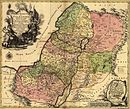
Holy places All Abrahamic ReligionsJudaismChristianityIslamRuling regimes Philistines / Canaanites / New Kingdom Egypt · Ancient Israel and Judah · Neo-Assyrian Empire and Neo-Babylonian Empire · Persian Empire · Hellenistic Greece and Hasmonean · Roman Empire · Byzantine Empire · Rashidun, Umayyad and Abbasid and Fatimid Caliphates · The Crusaders, Seljuks and Ayyubids · The Mamluk · Ottoman Empire · British Empire · Modern state of Israel / Palestinian territories / Egypt / Jordan
Wikimedia Foundation. 2010.

